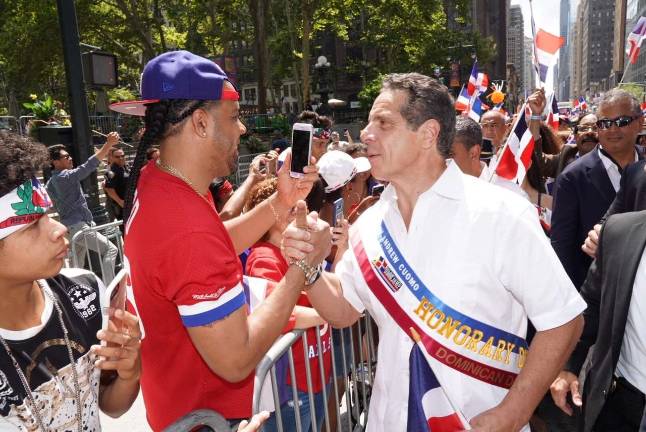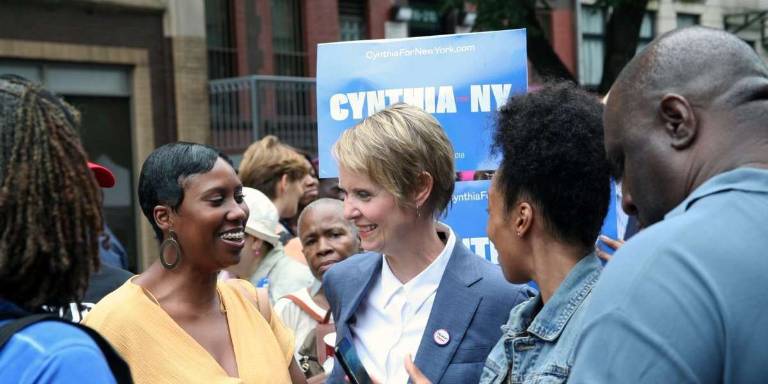how Your neighborhood voted


Cynthia Nixon scored a landslide triumph over Andrew Cuomo — in the two square blocks bounded by First and Second Avenues and East 10th and East 12th Streets in the East Village.
The insurgent racked up 184 votes to crush the incumbent governor, who managed only 86 votes, by a margin exceeding two-to-one in one of the city’s most liberal-left precincts.
Nixon also walloped her rival on Carmine, Morton, Leroy, Cornelia and Bleecker Streets in Greenwich Village. She romped on a two-block strip along West 100th Street between Broadway and Riverside Drive on the Upper West Side.
And her micro-sweep encompassed several long blocks of West 21st and 22nd Street in Chelsea, as well as both sides of East 67th, 68th and 69th Streets between York and First Avenues on the Upper East Side.
It wasn’t enough. Cuomo pulverized her. He won the statewide ballot by a 65.6 percent-to-34.4 percent margin. Even in Manhattan, where Nixon fared far better, she managed just 41.6 percent of the vote, while he snared 58.4 percent.
But as a pioneer in an emerging sisterhood of political newcomers vying to unseat male incumbents, Nixon notched some impressive wins:
She animated a liberal-left base, energized the electoral discourse and left a foundation for future progressive female challengers to build on in the hundreds of blocks and scores of Election Districts in which she did prevail.
Take the single square block bounded by West 106th Street to the south, West 107th Street on the north, Broadway to the west and Amsterdam Avenue on the east, where the tenants have historically included Columbia University students, professors and support staff.
Nixon amassed 210 votes on the block, trouncing Cuomo, who tallied just 158 votes.
Based on the unofficial election night results from the state Democratic Party primary on Thursday, Sept. 13, Straus News conducted a preliminary and unscientific street-level analysis of how dozens of the mini-neighborhoods of Manhattan voted.
The review focused on the borough’s 12 state Assembly Districts, and then drilled down into what is probably the states’ smallest political jurisdiction, the Election District, which can comprise an area as little as one city block, or at most, eight or nine blocks.
Known to political cognoscenti as EDs, the districts in Manhattan alone number in the thousands. For instance, in the 66th Assembly District, or AD, which covers Soho, Tribeca, Greenwich Village and the East Village, there are 106 EDs. Nixon won 74 of them.
Among the findings of the Straus News primary analysis, which was based on online data available on the New York City Board of Elections website:
• The 66th AD, represented by Assembly Member Deborah Glick, is the only AD that backed Nixon. She won handily, chalking up 10,574 votes to Cuomo’s 8,903.
• Within the 66th AD, she crushed the governor by a 208-to-138 margin in the 23rd ED, which runs from West Houston Street on the south to Bleecker Street on the north and from Crosby Street on the east to Greene Street on the west.
• Also in the 66th, she scored a two-to-one win in the 30th ED, drawing 164 voters from East 3rd, 4th and 5th Streets between First and Second Avenue against Cuomo’s 80.
• Nixon was unbeatable in Soho, cleaning up by hefty margins on West Broadway and Wooster, Mercer, Prince, Spring, Broome and Thompson Streets, also in the 66th AD.
“We’re going block by block by block by block,” the challenger said in a hopeful campaign speech back in June.
Those efforts sputtered in the face of the incumbent’s onslaught. And the establishment she had denounced as the “state’s old-boy network” roared into action, outspending and out-organizing her and marshalling unions, elected officials and political clubhouses to do lethal battle.
In the end, Cuomo had spent north of $23 million to win, while Nixon’s losing effort cost south of $3 million.
The review of unofficial Board of Elections returns, with 98 percent of vote scanners reported, also found that:
• The 68th AD, covering most of East Harlem, was Cuomo’s best district, and his 11,620 votes dwarfed the 4,755 that Nixon mustered.
• The two districts taking in the Upper West Side, the 67th and 69th ADs, were comfortable territories for Cuomo — even though Nixon had lived in the neighborhood for years — and he won them by 13,783-to-10,389 and 14,134-to-12,282 vote margins respectively.
• Within the 67th AD, the sprawling Lincoln Towers apartment complex flanking West End Avenue in the upper 60s gave Cuomo one of his best victory margins. In four EDs that take in most but not all of the eight-building, 20-acre campus, he tallied 1,136 votes to Nixon’s 561.
• The 76th AD, represented by Assembly Member Rebecca Seawright and taking in the Upper East Side and Roosevelt Island, was the scene of another Cuomo landslide as he took the district by 10,120 votes to the challenger’s 6,559.
• And within the 76th AD, he vanquished Nixon in the front yard of one of her closest political friends, and one of his favorite political punching bags, Mayor Bill de Blasio, who after long public ruminations ultimately endorsed no one in the gubernatorial race.
The 74th ED sits due west of Gracie Mansion and runs from East End Avenue to York Avenue along East 88th and East 89th Streets. Cuomo won it by a better than two-to-one margin, collecting 126 votes while Nixon managed 58.
invreporter@strausnews.com
Click here to see how Manhattan voted in the Democratic primary for governor.
Click here to see how your Assembly District voted in the Democratic primary for governor.
Click here to see how Manhattan voted in the Democratic primary for attorney general.
Click here to see how your Assembly district voted in the Democratic primary for attorney general.